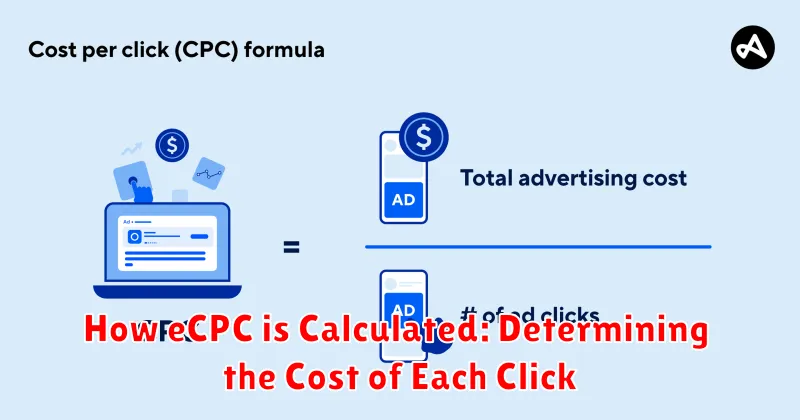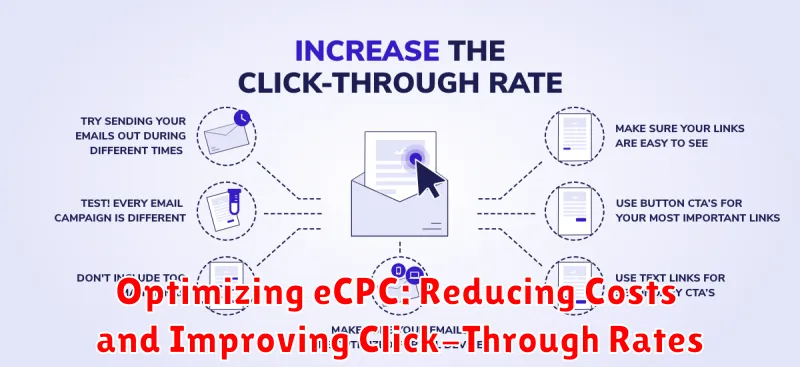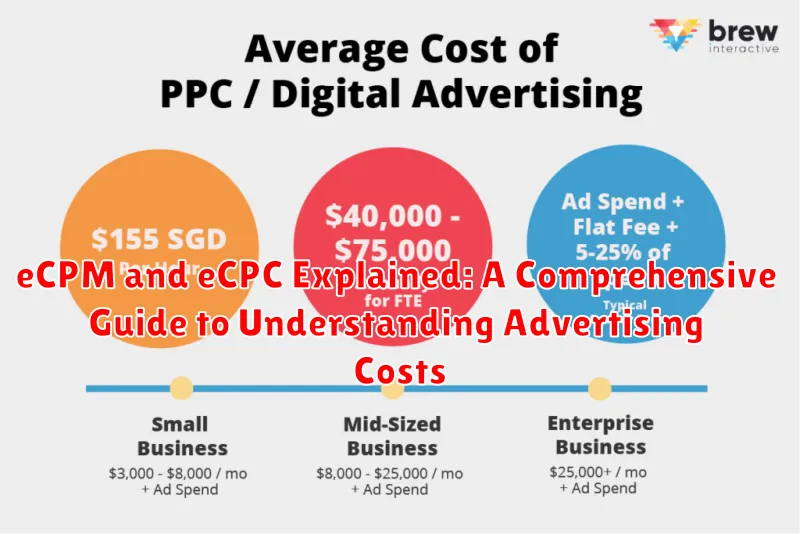In the ever-evolving landscape of digital advertising, understanding the intricacies of cost metrics is paramount for both publishers and advertisers. This comprehensive guide will delve into two crucial key performance indicators (KPIs): eCPM (effective cost per mille) and eCPC (effective cost per click). Mastering these concepts is essential for optimizing ad campaigns, maximizing revenue, and making informed decisions regarding advertising spend. Whether you are a seasoned marketing professional or just starting in the world of online advertising, this guide will provide you with the knowledge and tools you need to succeed.
We will explore the definitions of eCPM and eCPC, detailing how they are calculated and what factors influence their values. Furthermore, we will analyze the differences between these two metrics and their respective roles in evaluating the effectiveness of different advertising strategies. This guide will also present practical examples and real-world scenarios to illustrate how eCPM and eCPC can be leveraged to improve advertising performance across various platforms and channels. Prepare to unlock the secrets to efficient and profitable advertising through a deeper understanding of these vital metrics.
What is eCPM? Understanding Effective Cost Per Mille
eCPM, or Effective Cost Per Mille (mille is Latin for thousand), is a crucial metric in online advertising that represents the estimated revenue generated for every 1,000 ad impressions. It provides a standardized way to measure the profitability of ad campaigns across different platforms and pricing models.
Unlike CPM (Cost Per Mille), which is simply the cost an advertiser pays for 1,000 impressions, eCPM calculates the *effective* cost based on actual revenue earned. This makes it particularly useful for publishers using various monetization methods beyond simple CPM deals, such as CPC (Cost Per Click) or CPA (Cost Per Action) campaigns.
Essentially, eCPM allows publishers to compare the performance of different advertising strategies on a level playing field, regardless of how they are priced. By analyzing eCPM, publishers can identify which ad placements and formats are generating the most revenue per impression and optimize their inventory accordingly.
How eCPM is Calculated: The Formula and Its Components
eCPM, or Effective Cost Per Mille (thousand impressions), is a crucial metric for publishers and advertisers to understand the revenue generated from ad impressions. Its calculation is straightforward, providing a clear view of advertising effectiveness.
The eCPM formula is as follows:
eCPM = (Total Earnings / Number of Impressions) x 1000
Where:
- Total Earnings: The revenue earned from the advertising campaign within a specific period.
- Number of Impressions: The total number of times the advertisement was displayed.
For example, if an advertisement generates $500 from 100,000 impressions, the eCPM would be: ($500 / 100,000) x 1000 = $5. This means the publisher earned $5 for every 1,000 impressions of that ad.
Understanding this formula is essential for analyzing ad performance and making informed decisions about advertising strategies. By tracking and optimizing eCPM, publishers can maximize their revenue potential.
Factors Influencing eCPM Rates: What Drives the Price
Several elements impact the eCPM (effective cost per mille) rate, determining the ultimate price advertisers pay. Understanding these factors is crucial for publishers aiming to maximize ad revenue.
- Ad Placement: Ads placed in highly visible areas of a webpage or application typically command higher eCPM rates. Above-the-fold placements are generally more valuable.
- Ad Format: Interactive and engaging ad formats, such as video ads and rich media ads, often result in higher eCPM rates compared to static banner ads.
- Audience Quality: The demographics and interests of the website’s audience significantly impact eCPM. Advertisers are willing to pay more to reach a highly targeted and valuable audience.
- Seasonality: Certain times of the year, such as the holiday season, often see increased advertising demand and higher eCPM rates.
- Ad Quality: High-quality, relevant ads that resonate with the audience tend to perform better and generate higher eCPM rates.
- Geographic Location: eCPM rates can vary significantly depending on the geographic location of the audience. Tier 1 countries like the United States and the United Kingdom typically have higher rates.
Competition among advertisers also plays a significant role. When multiple advertisers are bidding for the same ad space, the eCPM rate is likely to increase.
What is eCPC? Understanding Effective Cost Per Click
eCPC, or Effective Cost Per Click, is a crucial metric in online advertising. It represents the actual cost you pay for each click your ad receives, after any adjustments from automated bidding strategies or other optimization techniques are applied.
Unlike a fixed cost-per-click (CPC) bid, eCPC reflects the effective amount spent per click, taking into account factors such as conversion rates and the likelihood of a click leading to a desired action. This metric helps advertisers understand the real cost associated with driving traffic to their website or landing page.
By analyzing eCPC, advertisers can assess the efficiency of their campaigns and make informed decisions about bidding strategies, ad placements, and targeting parameters. It provides a clearer picture of the return on investment (ROI) for each click, allowing for more effective budget allocation and campaign optimization.
How eCPC is Calculated: Determining the Cost of Each Click

Effective Cost Per Click (eCPC) represents the actual cost an advertiser pays for each click received on their ad campaign. Unlike a set cost-per-click bid, eCPC takes into account campaign performance and conversions. There isn’t a single, universally applied formula to calculate eCPC, as it often depends on the platform and the specific bidding strategy employed. However, the general principle involves analyzing the total cost incurred and the number of clicks generated.
A simplified representation of eCPC calculation can be expressed as:
eCPC = (Total Cost of Ad Campaign) / (Total Number of Clicks)
Where:
- Total Cost of Ad Campaign is the overall expenditure on the ad campaign during a specific period.
- Total Number of Clicks is the total number of clicks received on the ad during that same period.
It’s important to note that some platforms use more sophisticated algorithms for eCPC, taking into consideration factors like conversion rates and the value of each conversion.
Factors Influencing eCPC Rates: Targeting and Competition
Several factors contribute to the fluctuation of eCPC (effective Cost Per Click) rates. Primarily, the specificity and relevance of targeting play a significant role. Highly targeted campaigns, focusing on niche audiences with specific demographics, interests, or behaviors, often command higher eCPC rates due to their potential for increased conversion.
Conversely, broad targeting may lead to lower eCPC rates, but can also result in lower conversion rates, affecting overall campaign performance. The level of competition within the targeted market segment also directly impacts eCPC. If multiple advertisers are bidding for the same audience, the cost per click will naturally increase.
Furthermore, the quality score assigned to your ads by the advertising platform, based on factors like ad relevance, landing page experience, and expected click-through rate, can significantly influence your eCPC. Higher quality scores often result in lower costs per click and better ad positioning.
eCPM vs. eCPC: Choosing the Right Metric for Your Campaigns
Selecting between eCPM (effective cost per mille) and eCPC (effective cost per click) depends heavily on your campaign goals. eCPM is often favored when brand awareness and maximizing impressions are primary objectives. It allows you to pay for views, regardless of clicks.
Conversely, eCPC is suitable when driving traffic, generating leads, or securing conversions are paramount. You only pay when a user interacts with your ad by clicking it.
Here’s a simple guide to help you decide:
- Choose eCPM if: Your main goal is brand visibility and reaching a large audience.
- Choose eCPC if: Your main goal is driving targeted traffic and achieving direct conversions.
Carefully consider your budget, target audience, and key performance indicators (KPIs) before choosing the most suitable metric. A balanced approach, potentially incorporating both eCPM and eCPC campaigns, can also be effective in a comprehensive advertising strategy.
Optimizing eCPM: Strategies for Increasing Ad Revenue
To maximize ad revenue through eCPM, several strategic approaches can be implemented. These strategies focus on improving the value and appeal of your ad inventory to advertisers.
Enhance Ad Placement and Visibility
Strategic ad placement is crucial. Place ads in areas with high visibility and user engagement. Experiment with different ad sizes and formats to identify what performs best.
Improve Ad Quality and Relevance
Ensure your ads are of high quality and relevant to your audience. Use compelling visuals and clear, concise messaging.
Targeting and Audience Segmentation
Refine your targeting strategies to reach the most receptive audience. Segment your audience based on demographics, interests, and behavior to deliver personalized ads.
A/B Testing and Continuous Optimization
Conduct A/B testing to experiment with different ad creatives, placements, and targeting parameters. Continuously analyze performance data and make adjustments to optimize eCPM.
Optimizing eCPC: Reducing Costs and Improving Click-Through Rates

Optimizing effective Cost Per Click (eCPC) is crucial for maximizing the return on investment in digital advertising campaigns. This involves implementing strategies to lower the cost incurred for each click while simultaneously enhancing the click-through rate (CTR).
Strategies for Reducing eCPC
Several tactics can be employed to reduce your eCPC. These include:
- Refining Keyword Targeting: Focusing on more specific, long-tail keywords can attract a more qualified audience and lower bidding costs.
- Improving Ad Quality Score: Platforms like Google Ads reward ads with high quality scores, leading to lower eCPCs. This involves relevant ad copy, landing page experience, and expected CTR.
- A/B Testing Ad Creatives: Continuously testing different ad variations (headlines, descriptions, calls-to-action) helps identify the most effective combinations and improve CTR.
- Audience Segmentation: Targeting specific demographics and interests allows for more personalized ads, increasing relevance and click-through rates.
Enhancing Click-Through Rates
A higher CTR directly contributes to a lower eCPC and overall campaign success. Focus on crafting compelling ad copy, using visually appealing creatives, and ensuring a seamless user experience from the ad to the landing page.
Using eCPM and eCPC Together: A Holistic Approach to Advertising Costs
While eCPM (effective cost per mille) and eCPC (effective cost per click) appear as distinct metrics, their integrated application provides a more comprehensive understanding of advertising performance. By analyzing both, advertisers can gain insights beyond surface-level data and optimize campaigns for maximum efficiency.
A holistic approach involves using eCPM to gauge overall revenue generation relative to impressions and employing eCPC to evaluate the cost-effectiveness of individual clicks. This dual perspective enables informed decisions regarding ad placement, targeting strategies, and creative optimization.
For instance, a high eCPM might indicate strong revenue, but a corresponding high eCPC could suggest inefficiency in click acquisition. Conversely, a low eCPM paired with a low eCPC could signify a cost-effective campaign, albeit one with limited reach. By considering these metrics in tandem, advertisers can identify areas for improvement and allocate resources strategically.

